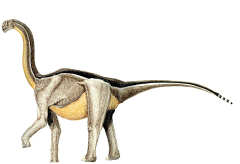Please obtain a javaScript capable browser such as
Netscape Navigator or
Microsoft Internet Explorer
Mass Extinctions: Lesson glossary .
I. The Death of the Dinosaurs
Observations
Iridium found in geologic strata at K-T boundary
Meteorite crater near IndiaImpact quartz in India
Several asteroid craters discovered around the planet
Hypotheses
Catastrophe theories
Giant asteroid struck Earth, spewed up dust and smoke into the
atmosphere, climate cooled, vegetation withered, dinosaurs starved
Giant volcanic eruptions spewed ash into atmosphere, climate cooled,
vegetation withered, dinosaurs starved
Giant asteroid struck Earth, triggered massive volcanic eruptions, climate cooled,
vegetation withered, dinosaurs starved
Uncertainty
Atmospheric particulates could have originated from either meteorites or
volcanoes
Impact quartz could have originated from either meteorites or volcanoes
Iridium could have originated from either meteorites or volcanoes
Gradual climatic changes could account for dinosaur's demise
It took 100,000 years for dinosaurs to die out II. What killed the dinosaurs
K-T boundary, 65 million years ago
Cretaceous period (K) dominated by conifers and dinosaurs
Tertiary period (T) dominated by flowering plants and mammals
Hypotheses
Impactor: swarm of meteorites pelted the earth, one at least 10 km
across
Volcanist: extensive volcanic eruptions
Indications - correlations
Iridium
in relatively large concentrations in clay layer in Gubbio (Italy); subsequent
discoveries of iridium at K-T boundary around the world
Impact quartz at meteorite craters
Rock spherules: tektites
Impact craters: Haiti, Cuba, Iowa
Stepwise extinctions occurred over a few million years
Killing mechanism (hypotheses)
Oblique impact simulation
Meteorite at low angle would break up into a swarm of fragments which
would block sunlight and fall back down gradually Acid rainShock-heated atmosphere caused oxygen and nitrogen to
form nitric acid which rained down, caused the three-meter gap Thermal radiationVaporized rock heated the atmosphere and
burned the earth, graphitic carbon Greenhouse effect
Impact produced 2 - 5 times CO2 overnight, inferred
climate change from disappearance of marine algae
Patterns
Groups
Certain groups of land and ocean organisms went extinct gradually
before K-T boundary
Some groups went extinct shortly after the K-T boundary
Many groups suffered catastrophically right at the boundary OceanTropical groups and plankton feeders most vulnerable
Species with resting spores survived best (diatoms and dinoflagellates)
Scavengers and detritivores had an advantage Land
Large reptiles suffered the most
Flowering plants recovered rapidly: protected seeds, spores, rhizomes
Insects and insectivores had an advantage
Periodicities
Other mass extinctions occurred in Earth's history
Statistical analysis of extinctions suggested a period of 26 million years
Hypotheses: Nemesis, Planet X, solar system oscillations
Volcanist alternative
Sulfur dioxide clouds would briefly cool the planet and rain acid
Carbon dioxide would produce a greenhouse effect for years
Hot spot volcanoes could bring up iridium from earth's core and create
impact quartz
Math and physical models contain thermal boundary layers and
magnetic field reversals
Scientific process
Some erroneous hypotheses die hard
Value of a new hypothesis leads to debate which stimulates research to
obtain new data III. Mass extinctions in the oceans
Extinctions
Background : plant and animal species die out at a low, constant rate
Mass extinction : sharp peaks in the number of vanishing species
associated with radical changes in regional/global environment
Temperature
Temperature discontinuity often marks the boundary of a species'
geographic range
Evidence of changing temperatures reflected in glacial gravels and
loss of species adapted to warm water or a narrow temperature range
Hypotheses for mass extinctions
Observations
A narrow continental shelf can harbor an enormous diversity of
bottom-dwelling organisms
Biotic crises are not correlated with changing sea levels
A large number of species vanished during the Ice Age
Extinctions concentrated on warm water species
Survivors of extinction episodes are adapted to cool temperatures, e.g.,
globigerines
Switch from tropical to temperate forests at end of Eocene
K-T boundary
Faunas of the Tethyan Sea suffered most
Coccolithophores, planktonic
foraminifera ,
reef-building rudists,
ammonoids Strata in Denmark and North Dakota showed that many Cretaceous species
lived several million years more before going extinct
Biotas from cool, northern latitudes shifted southward
Ammonoids and inoceramid bivalve molluscs declined gradually and went
extinct before the boundary
Top of food chain went extinct before the base
Time lags in the evolution of species diversity after an extinction
episode might account for apparent periodicity
Other mass extinctions
Late in Precambrian: extinction of acritarchs was correlated with glaciation
Ordovician: extinction of trilobites
and graptolites, glaciation originating in N. Africa
Devonian: tropical marine groups disappeared while cool water species fared well, e.g. glass
sponges
Permian: complex, with warming first followed by cooling
Patterns
Oldest marine animal species are those adapted to cold water
Tropical animals have come and gone rapidly in geologic time
Tropical species are often adapted to a narrow range of warm temperatures; no refuge in times
of cooling When you have completed this lesson, go on to Review Questions
William.Gaud@nau.edu Copyright 2000
Northern Arizona University 
 Copyright 2000
Northern Arizona University
Copyright 2000
Northern Arizona University